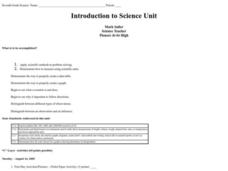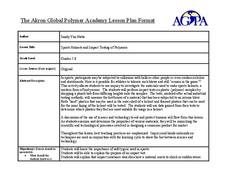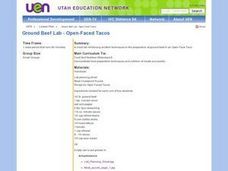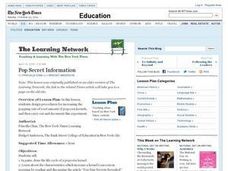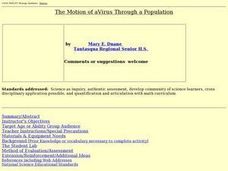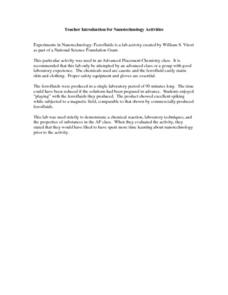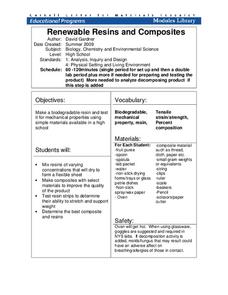American Chemical Society
Energy Foundations
Only 10 percent of an incandescent bulb's energy is used to create light; the remaining 90 percent is heat. In the unit of activities, young chemists examine energy through hands-on activities, videos, discussions, and...
Curated OER
Introduction to Science
Seventh graders investigate scientific methods to solve problems. They demonstrate creating data tables and graphs. They study the role of a scientist and the importance of safety in a science lab. They distinguish between an...
Curated OER
Group Rotation
Ninth graders review lab equipment safety procedures and utilize safe and behavior while there. They then edit and combine digital photographs to create realistic images using Adobe Photoshop.
Curated OER
Sports Helmets and Impact Testing of Polymers
Learners examine the importance of good quality safety gear. In this investigative activity, students will tests various polymers, collect data, and analyze the data to determine which polymer is best for safety helmets. They will design...
Curated OER
Oceanic Absorption- Oceanic Sequestration
Students examine the different techniques that may be used to reduce carbon dioxide in the atmosphere. In this ocean pollution instructional activity students divide into groups and complete a lab to see how the ocean holds carbon...
Curated OER
Geologic Sequestration
Students investigate how geologic sequestration reduces carbon dioxide concentration in the atmosphere. In this earth science lesson, students simulate oil mining in the lab. They write down their observations and complete the lab report...
Curated OER
Open-Faced Tacos
Students practice safe handling procedures in a lab experience by handling ground beef properly in the preparation of a recipe. They prepare and assemble Open Faced Tacos. Afterward, they eat their prepared meal and complete several...
Curated OER
Stalactites And Stalagmites
Students conduct a scientific investigation about the formation of stalactites and stalagmites. They conduct an experiment to reproduce them in the lab environment. Students make observations over a period of time in order to see the...
Curated OER
Pop Secret Information
Young scholars design procedures for increasing the popping rate of a set amount of popcorn kernels. They propose and test a "secret" addition to the corn popping procedure which they expect would increase the popping rate and then write...
Curated OER
Determine the molarity of an unknown HCl solution
Students complete a lab to help develop a comprehension of stiochiometry. They review equation writing, equation balancing, and stiochiometry. Studnets are given the following information: Sloppy students from the previous class have...
Curated OER
Human Epidermal Cells
Students explore epidermal cells. After following specified procedures for removing epidermal cells from their wrist, students view the cells with the use of a microscope. After creating a drawing of their observation, students label the...
Curated OER
The Motion of a Virus Through a Population
Students test the factors that influence the rate at which a virus spreads through a population. They complete a lab activity then discuss data collected and review and answer a set of questions.
Curated OER
Experiments in Nanotechnology: Ferrofluids
Students explore the world of nanotechnology by synthesizing ferrofluids in a series of chemical reactions. In small groups, they follow the procedure to create the ferrofluids using precise measuring techniques. They test the resulting...
Curated OER
Hypothermia: Temperature Changes Under Varying Conditions
Students conduct an experiment to determine what type of clothing would be most suitable for outdoor activities. They determine the temperature changes of the skin under various wet clothing materials and graph the temperature changes. ...
Curated OER
Comparing Ovaries And Testes
In this reproductive system learning exercise, students compare specimens of rat ovaries and testes. They complete 5 short answer pre-lab questions, follow an 11 step procedure and answer 5 analysis questions.
Curated OER
Density Of A Material
Students determine the density of a material created in the laboratory and observe physical and chemical changes. They engage in a lab activity, and answer questions on a worksheet imbedded in this plan.
Curated OER
From Polymers to Bioplastics: Looking Toward Finding Renewable Resources
Students investigate the properties of polymers. In this chemistry lesson, students explain the importance of energy sources. They produce a bioplastic from the lab and evaluate its structural integrity.
Cornell University
Glued into Science—Classifying Polymers
Explore the unique characteristics of polymers. A complete lesson begins with a presentation introducing polymers. Following the presentation, young scientists develop a laboratory plan for creating substances using polymers. They...
Cornell University
Making a Battery
Don't be shocked when your class has a blast making their own batteries! Science scholars examine a dry cell battery, then design and construct a wet cell battery. The activity guides them through the parts of a battery, the variables...
University of Georgia
Monohybrid Crosses and The Punnett Square Lesson Plan
Looking for a quick, hands-on activity to teach young scientists about Punnett squares through monohybrid crosses? then check out this one.
Cornell University
Renewable Resins and Composites
Merge chemistry with environmental science to study biodegradable materials. An engaging activity allows learners to experiment with different resin concentrations and composites. Through experimental tests, scholars test their creations...
Chymist
The Extraction and Identification of Artificial Food Colors
Did you know some food dyes are considered safe while others are considered carcinogenic? During the experiment, young chemists extract artificial food colors from prepared foods. Then, they use chromatography paper to identify...
National Nanotechnology Infrastructure Network
Lines on Paper - Laser Box
See what you cannot see by getting a little creative. An intriguing lesson has learners use lasers to explore X-ray diffraction. Given a box with unknown structures, they shine a laser through the box and interpret the results....
Texas State Energy Conservation Office
Investigation: Insulation
Youngsters compare the heat-holding abilities of three different cans by insulating two with different materials and measuring the temperature change of hot water over a 20-minute period.

